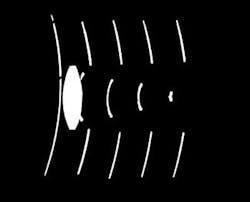Article may have left false impression that light-in-flight method is new
The article “3-D movie shows femtosecond pulse propagation,” (January 2008, p. 36; wwwlaserfocusworld.com/articles/317039) presents a method of light-in-flight recording by holography and reports: “For the first time, three-dimensional (3-D) images of femtosecond light-pulses have been observed and recorded by researchers at the Kyoto Institute of Technology (Kyoto, Japan). The continuously moving pictures are produced using holographic light-in-flight techniques and enable the temporal and spatial analysis of femtosecond pulses for improving studies of ultrafast phenomena.”
There is no doubt that the light-in-flight technique has great potential in optics. However, the reader might get the impression that it is totally new, which is wrong. What is new in the article is that the 3-D light pulse is studied in a scattering medium, while usually its cross sections are studied on a flat screen.
Temporal and spatial analysis using light-in-flight has been described in a number of publications beginning in 1978.1 Readers might have been interested to see references to some of those publications. I would have appreciated if the story had referenced the book Light-in-flight, or the Holodiagram the Columbi egg of Optics that, like a 1983 paper, explains in detail the functions of light-in-flight.2, 3 See also a 1991 article in Laser Focus World.4
The work at Kyoto Institute of Technology has the distinction of representing the true volume in 3-D of the light pulse. Such recordings have also been published by H. Hinrichs et al., but for a different purposeto study the scattering particles themselves.5 However, most light-in-flight recordings represent flat 2-D intersections of the 3-D pulsefronts, and the advantage of that method is that cross sections are easier to study and to measure than more or less diffuse clouds of light.
Finally, I want to present the first image of pulsefronts focused by a lens. It was made in 1981, the pulses are 10 ps long, and the photo represents five film frames taken from one single hologram (see figure). The image of the lens is added manually for clarity.
Nils Abramson
Professor Emeritus
Industrial Metrology and Optics
Royal Institute of Technology,
10044 Stockholm, Sweden
[email protected]
REFERENCES
1. N. Abramson, “Light-in-flight recording by holography,” Optics Lett. 3(4) 151 (October 1978).
2. N. Abramson, Light-in-Flight or The Holo-diagram: The Columbi egg of Optics, SPIE Press, Vol. PM27 (September 1996).
3. N. Abramson, “Light-in-flight recording: High-speed holographic motion pictures of ultrafast phenomena,” Applied Optics 22(2) 215 (Jan. 15, 1983).
4. J.A. Valdmanis and N.H. Abramson, “Holographic Imaging Captures Light in Flight,” Laser Focus World 27(2) 111 (February 1991).
5. H.Hinrichs et al., “Light-in-flight holography for visualization and velocimetry in three-dimensional flows,” Optics Lett. 22(11) 828 (June 1997).
We welcome your comments. Send letters to Carol Settino, managing editor, at [email protected]. Letters may be edited for length.

